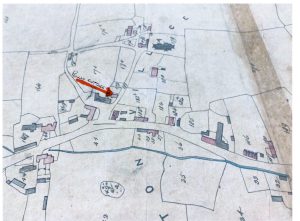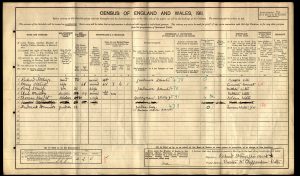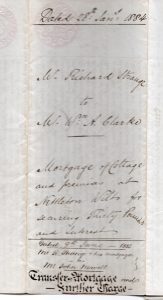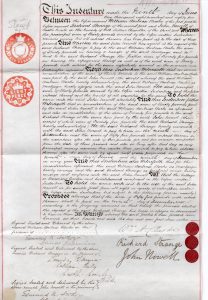Author: Chris Bennett
Pound Cottage, Burton (early/mid C18th) – (Part 1)
This article will primarily focus on providing some brief information on a house known as Pound Cottage, situated on Church Hill, Burton. We hope you can get a flavour of some of the history surrounding this building and its role within the local area. You will also see that I have digressed a little to include some rather interesting historical links to the area. Should any further information be forthcoming about this building we will provide this in future articles. Here is what we know so far…….
The word ‘pound’ comes from the old English word ‘pund’, meaning pen or enclosure.
A Village Pound was a feature of most British medieval villages, usually a high walled and lockable structure, serving several purposes. The most common was to hold stray sheep, pigs, cattle and geese until they were claimed by the owners, usually for payment of a fine or levy, this would include an amount claimed by person on whose land they strayed and damage done, a fee to the Pound keeper for feeding/watering the animals. If they were not claimed in three weeks, the animals were driven to the nearest market and sold, the proceeds going to the impounder and Pound keeper.
An ingenious form of receipt was sometimes used. The person who found the animal(s) on their land cut a stick and made notches, one for every beast, then split the stick down the centre of the notches so that half of each notch appeared on each part of the stick. One half was kept by the finder and the other half given to the Pound keeper. When the owner came to redeem their animals/pay for damage done, the impounder gave their half of the stick to the owner. This was then taken to the Pound keeper and if the two pieces of stick tallied, it proved payment and the animals freed. Hence the word tally-stick and the Pound keeper being referred to as the ‘tallyman’
A village Pound was also sometimes used as an early form of gaol or lock-up to hold petty criminals such as rustlers, thieves and vagabonds until they could be dealt with by the local sheriff or magistrate. A Pound was often associated with the village stocks as a place of public humiliation and punishment.
What do we know about Pound Cottage, Burton
From records provided by The Wiltshire & Swindon History Centre we obtained copies (as below) showing the Plans of the Parish of Nettleton (dated 1802 & 1839). I also viewed a map named Andrew and Dury’s dated (1773) and although the scale of markings for identification of houses/buildings is very minute, even with a magnifying glass was unable to see a trace of Pound Cottage. Similar period buildings such as Church Cottage was visible on the map. This possibly indicates Pound Cottage was built after (1773), although not definitive.
From the plan (dated1802) we can see Plot number 70 representing the location of the Pound Cottage.
Plan of Nettleton Parish (1802) – belonging to Rt. Hon. John Howe (Lord Chedworth)

Who was the Rt. Hon. John Howe (Lord Chedworth (1754-1804)
He was the 4th Baron Chedworth the son of Thomas Howe (died 1776), rector of Great Wishford and Kingston Deverill, Wiltshire. His mother was Frances, daughter of Thomas White of Tattingstone near Ipswich, Suffolk. His paternal grandfather was John Howe, 1st Baron Chedworth. Howe was educated first at Harrow School,where he gave early signs of what was to be a lifelong interest in the stage and the turf. He matriculated at The Queen’s College, Oxford, on 29 October 1772, but left without a degree after three years’, and took up residence at his mother’s house at Ipswich. His mother died in 1778.
In 1781 he succeeded his uncle, Henry Frederick Howe, 3rd Baron Chedworth, in his title and estates, but continued to live in comparative seclusion, and seldom visited his properties in Gloucestershire and Wiltshire.
Late in life he lived in Great Yarmouth, the house of his friend Thomas Penrice (1757–1816), a musician and a collector of paintings, descended from a Worcestershire family. He devoted himself to a study of Shakespeare. Howe died unmarried on 29 October 1804, and the barony became extinct. He was buried, as he had directed, beside his mother in Ipswich, on the fifth day after his death. The inscription on his monument in the church describes him as a man of cultivated tastes and of Whig sympathies.
He left much money to his friend Penrice. and large legacies were left to his executors and trustees, by whom the Howe estates (approx. 1,900 acres) in Gloucestershire and Wiltshire (including a large area around Nettleton & Burton) were divided and sold (as 25 lots) in 1811 for £268,635 an equivalent value at today’s price of £33 million. Chedworth’s relatives unsuccessfully disputed his will on the ground of insanity.
Thomas Penrice
You may recall Penrice was Lord of the Manor (Kilvrough estate), around Swansea and a friend of George Scrope MP who lived at the Manor House, Castle Combe. as mentioned in a previous Bugle newsletter article about the Old House at Home public house.
From the plan dated (1839) we can see Plot number 172 representing the location of the Pound Cottage. Also note the land adjacent to this building (plot number 173) which represents the area known as ‘The Pound’
As mentioned in previous Bugle articles, the early records don’t provide the names of any buildings, merely giving only a Plot number(s) and a loose description of the building/structure such as ‘cottage and garden’ therefore the identification of a building has been done on the basis of recognition by the article writer.
Plan of Nettleton Parish (1839)

Researching records entitled ‘Rent Charges in Lieu of Tithes in the Parish of Nettleton of 1838 revealed the following information:
Plot (172) was occupied by a William Strange and family. The building was owned by the Trustees of Andrew Carrick M.D. (deceased) and contracted to be sold to a David Banks. Carrick also owned the land plots numbered 33, 34 & 35 above, identified as a garden and orchards.
Who was William Strange?
Census records (1851 & 1861) for Nettleton Parish (shown below) revealed William lived with his wife Elizabeth, 3 sons and a daughter. He was shown to have an occupation as a butcher of pigs. One of his sons Richard can be seen to be living at Pound Cottage in the 1911 census and is identified within the title deeds of the house (as shown below) dated 1884


Who was Andrew Carrick (1767-1837)
It is believed he was a senior physician at the Bristol Royal Infirmary and in1834 co-wrote a book entitled the Medical Topography of Bristol. He lived at Marlwood House, Alveston, Gloucestershire.
What did we find next during this research?
On checking a book entitled ‘Duties on land Values 1909-1910 we discovered entry numbers 87 (identified as Pound Cottage), now occupied by a Richard Strange & 141(identified as a Village Pound) owned by Nettleton Parish Council. Through census records for 1910 (as shown below) we can see Richard Strange, a gardener lived at Pound Cottage with his extended family and a boarder.

Extract from the Title Deeds of Pound Cottage – 22nd November 1823. As provided by Simon & Kim (present occupiers) – 2023
What is an indenture in property law?
A deed made between two or more parties who are not acting as one person. The word indenture originated in the days when the requisite number of copies of a deed would be engrossed onto a single piece of parchment, which would then be cut into individual deeds, with each party holding his own copy.
An Indenture of Conveyance is effectively just an ‘old fashioned’ alternative name for a conveyance.


Perhaps that is enough information for now, it’s far too easy to continue delving into archives and losing sight of my original plan to uncover information on Pound Cottage, maybe more in a later Bugle article. I have more details of an Indenture dated 1823 between William strange and a Thomas Hart, so watch this space !
The Bugle Editorial Team would like to thank current residents (Simon & Kim) for providing some of the fascinating story behind one of our historic village buildings.
Reference Material:
With grateful thanks to The Wiltshire and Swindon History Centre in Chippenham



0 Comments